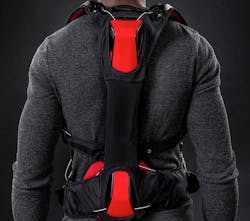Some technology and robots are keeping employees in the workplace by improving productivity, reducing cost, and increasing safety (see "What's the Difference Between Automation and Employment?"). Looking at the cost of the production/cost ratio, the Bureau of Labor Statistics reported that in 2012, injuries caused by jobs that involved lifting, pushing, pulling, holding, and repetitive motions accounted for 28.4% of workplace injuries that cost $16.94 billion. These injuries and costs are driving the need for automation and robotics to reduce injury from tedious, monotonous, or dangerous jobs.
Companies such as Strong Arm are working on soft exoskeletons (see below) to promote ergonomics and reduce injuries, while ReWalk, Cyberdyne, and Lockheed Martin are a few of the companies that have designed and prototyped active or hard exoskeletons. Exoskeletons could prevent debilitating lifting injuries or help decrease rehabilitation time. In addition, standards are reducing a robot’s operating speeds so it can operate safely with employees without a cage.
Called collaborative robots, companies such as Universal Robots, Fanuc, and other companies are removing safety cages to let workers work side-by-side with robots to help relieve stress from repetitive or tedious motions. Collaborative robots may not only reduce the cost associated with injury, but also alleviate an employee from monotonous work to focus on more complex tasks.
Meanwhile, the Industrial Internet of Things (IIoT) and modern robotics are spreading automation by offering more low-volume and flexible solutions that previously may not have made economic sense. This can help reduce the amount of workers, and time workers spend in the field or hazardous environments. For example, autonomous robots that are self-driving can roam in a set area with a sensor package. This helps keep a worker out of the way of danger while gathering valuable information.
“Also, today’s U.S. workers want jobs that are more interesting, safe, and offer opportunities for advancement,” says Jeff Burnstein, President of the Association for Advancing Automation (A3). “Tedious, manual jobs tend to have high turnover, which drives up costs for recruiting and training, while workers who stay in those positions can drag down productivity with low morale. Robots are the ideal replacement for these repetitive, low-wage positions, and allow companies to move employees into more appealing, career-oriented positions.”

